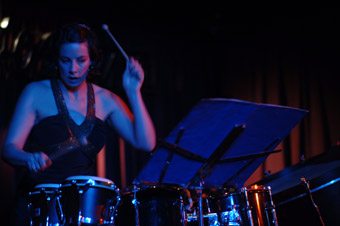 |
Claire Edwardes |
Coil is a wonderfully apt image for the album, conjuring something wound, expanding and contracting, full of force but also of a controlled unleashing of sounds delicate and powerful, whether in a music box or a grand pendulum clock or, as realised here, on vibraphone, marimba and drums. The compositions on the CD beat and pulse regularly as we would expect of percussion but, by turns, they dance, muse, grow introspective, dramatic and ache for transcendence.
In Brophy’s Coil (8’39, 1996) little melodies surge, rise, turn back on themselves and take flight again generating a palpable optimism. I wanted to invent words to sing with these sparkling, bell-like vibraphone musings and the rise and fall of their memorable cadences in Edwardes’ able hands. In contrast, Andrew Ford’s The Armed Man (5’42, 2004) is, the composer says, founded on a mediaeval tune. We don’t hear it, besides the tonal range is restricted to a drum kit, but the effect is powerful, a drum solo without a band, hinting at things ceremonial (march, attack, execution) and even rock’n’roll and, for Ford, the Iraq War,
Ross Edwards’ More Marimba Dances (7’05, 2004) furthers the magic of the widely played earlier set and had me on my feet. Edwardes and producer Belinda Webster bring to the trio of dances an enveloping range and depth of sound, the timber ringing with sublime bottom notes and high ripplings, resonating with buried references to music Latin and Asian and Baroque. The first and last dances open with buoyant riffs that you quickly embody—they are the springs out of which the compositions rise before falling and rising again—while the middle piece revels in an elegant tentativeness. Refreshing is the word for More Marimba Dances, and they are never less than utterly intelligent.
Next, in works by Andrew Schultz, Dominick Karski and Damien Ricketson, I found myself in very different, more demanding territory. Schultz’s Winter Ground [12’05, 2000] for vibraphone, is palpably reflective, establishing an ambiguous emotional state and working it over and over, winding and entwining, growing denser by accrual, expanding from a narrow note range into a stream of consciousness reverie with just enough of a rhythmic anchor to keep the work sensually engaging, often quite beautiful, right to the final residue of the repeated ringing of a single note. Something has been completed.
Dominik Karski’s Beginnings to No End [7’45, 1999], writes the composer, comprises “seven short fragments called ‘beginnings’—small pockets of musical material that could have been developed further, but instead collapse unexpectedly.” Fast pulsed, insistent ‘beginnings’ on marimba first simply stop. The impulse to cease soon seems to come from the instrusion of a very different voice. Sweet marimba and gruff bongos dialogue, a remarkable exchange which must have stretched Edwardes, brain and limb until, finally, the marimba takes off on its own, happily monologuing, galloping, riffing, locked into a final pulse with minute diversions, into...
Damien Ricketson describes his Hol Spannen Luiden [18:12, 1997] as “a variation without a theme”, “a recounting of a musical work where the original is never heard”, with a focus on “the nature of memory, in particular processes of recollection and decay.” The most demanding work on the CD, this work requires several listenings before it takes because it forsakes obvious beat and pulse for the very textures of percussive sound—small rolls, the vibration of dropped sticks, the natural reverberation of struck metal, all listened to and pondered in very real time. Once relaxed into, Hol Spannen Luiden is subtly if sparely immersive.
The CD closes with a return to more accessible material but both pieces have their own complexities. Mark Clement Pollard’s Just a Moment (3’20, 1996) has a gentle minimalist-cum-gamelan feel on vibraphone with brisk phasing which yields upper end sparkle and a mid-range pealing, generating rich layering in mere minutes. It’s fascinating that in a reversal of expectation, the cyclical melodic drive for Just a Moment comes from the top end of the instrument, while the occasional mid-range notes suddenly colour the composition from below. Pollard’s One Sweet Moment (3’00, 1997) starts ringing strongly, if hesitantly, like carolling bells, and subsequently takes shape as a continuous pealing with an emphatic beat, the intervals finally opening out, the pulse slowing, decayed notes hanging...These are brief works, but feel big and embracing and leave a glorious ringing in the ears.
Claire Edwardes has located the kinetic energy in these compositions and let them uncoil. With each play of the CD, their magic is released.
Claire Edwardes, Coil, recording engineer, producer Belinda Webster, mastering Don Bartley, Tall Poppies, CD TO193, www.tallpoppies.net
See giveaways (p56).
RealTime issue #81 Oct-Nov 2007 pg. 48
© Keith Gallasch; for permission to reproduce apply to [email protected]








 back
back